Marketing Report: Developing Brand Strategy for Starbucks in Sri Lanka
VerifiedAdded on 2020/06/03
|9
|2125
|44
Report
AI Summary
This report provides a comprehensive analysis of branding and brand equity within the context of marketing and management, with a specific focus on Starbucks. It begins by defining brand equity and its components, including brand experience, identification, preferences, and loyalty. The report then delves into Keller's brand equity model, exploring brand identity, meaning, and responses. Various methods for building brand equity are discussed, such as product positioning, customer service, and employee training. The report also outlines how organizations measure brand equity and examines brand reinforcement and revitalization techniques. Finally, it proposes a brand strategy for Starbucks to establish its presence in Sri Lanka, covering aspects like market analysis, target customer identification, brand positioning, and message development. The report concludes that brand equity is crucial and effective strategies are vital for business success. The report uses academic journals and online sources to support its claims.
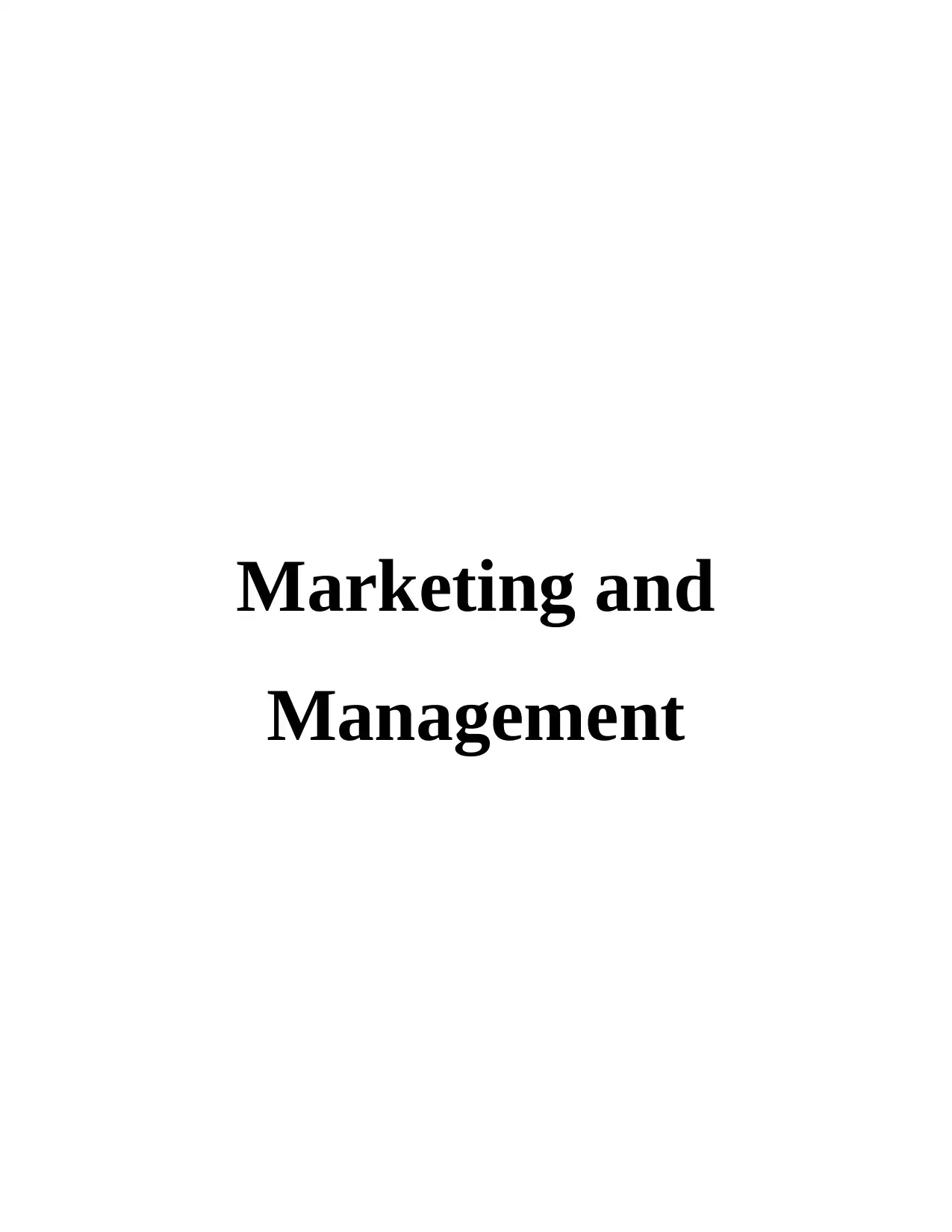
Marketing and
Management
Management
Paraphrase This Document
Need a fresh take? Get an instant paraphrase of this document with our AI Paraphraser
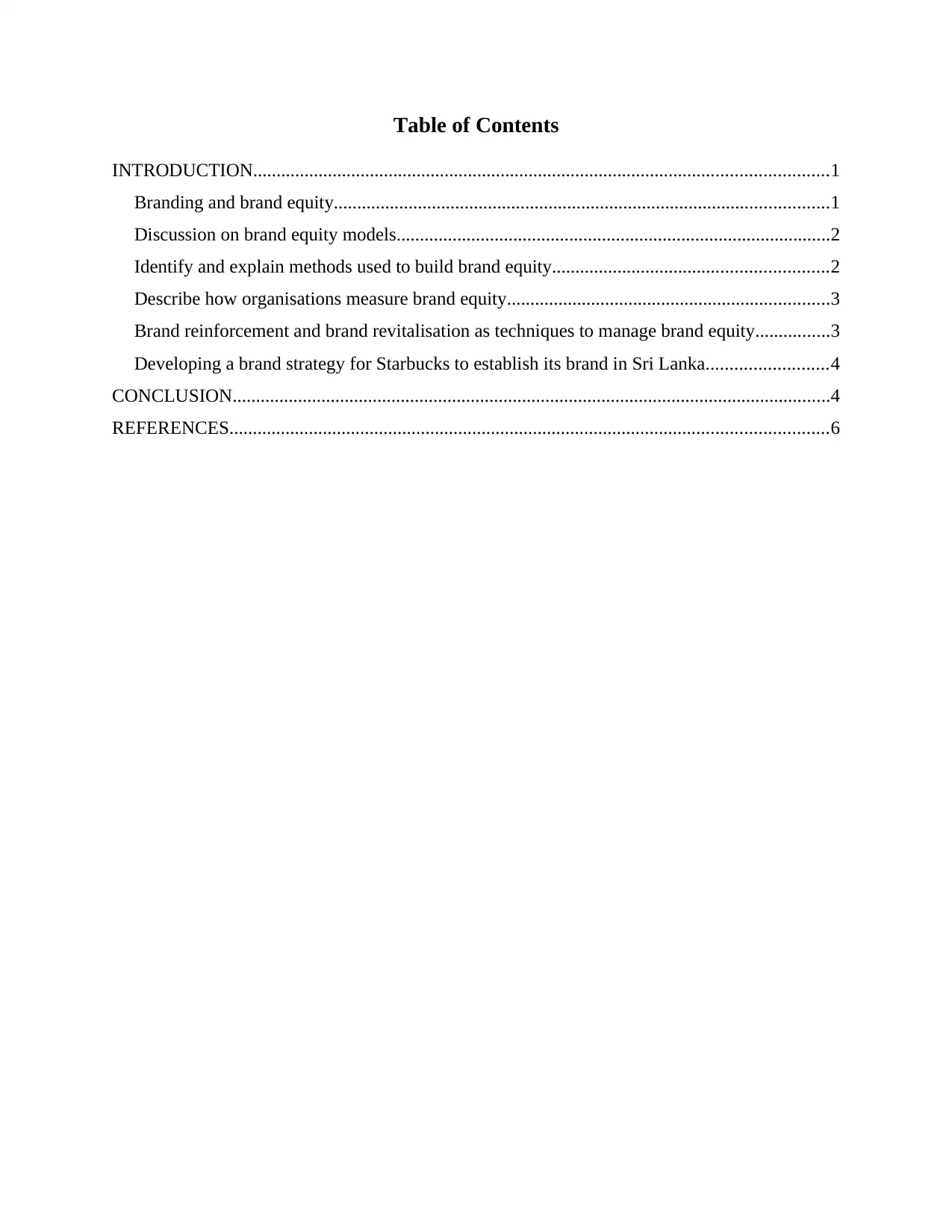
Table of Contents
INTRODUCTION...........................................................................................................................1
Branding and brand equity..........................................................................................................1
Discussion on brand equity models.............................................................................................2
Identify and explain methods used to build brand equity...........................................................2
Describe how organisations measure brand equity.....................................................................3
Brand reinforcement and brand revitalisation as techniques to manage brand equity................3
Developing a brand strategy for Starbucks to establish its brand in Sri Lanka..........................4
CONCLUSION................................................................................................................................4
REFERENCES................................................................................................................................6
INTRODUCTION...........................................................................................................................1
Branding and brand equity..........................................................................................................1
Discussion on brand equity models.............................................................................................2
Identify and explain methods used to build brand equity...........................................................2
Describe how organisations measure brand equity.....................................................................3
Brand reinforcement and brand revitalisation as techniques to manage brand equity................3
Developing a brand strategy for Starbucks to establish its brand in Sri Lanka..........................4
CONCLUSION................................................................................................................................4
REFERENCES................................................................................................................................6

INTRODUCTION
Branding and brand equity is used in marketing sector that describes the value of specific
brand name and it is based on idea and thoughts which make innovative products and services.
All the organisation can change their branding and packaging scenario which help in attracting
more customers towards creative commodities. Starbucks is the multinational coffee company
which is situated in Sri Lanka (Shaw, 2016). It operates almost 23,768 locations in all over the
world. They provide branding coffee which gain attention of desired buyers towards particular
goods and services. Brand is the design, name, symbol and any other sign which represents each
product different and it assist in easily recognised the specific products and services as compare
with others commodities in the market. They required to build more identification by more and
more people and easily became the brand equity and play an important role in marketing
strategy.
“Building a Brand Strategy through Brand Equity”
Branding and brand equity
The brand refers to the design, symbol and sign which appear on the particular products
and it help in easily identified goods which they required. Brand equity is the form of point of
view of individual buyer and it is based on attitudes of consumers which are changes whether it
is positive abilities or result to use brand quality. There are various way in which firm will help
in making positive brand equity in each manner (.Desbordes, 2012). It also provide the chance to
expand their products line that will enhance sales and income of the business and in some
situation they will reduce cost. There are some components of brand equity which are discussed
as follows:
Brand experience- The consumer will used this elements which assist in building
expectation of products and services.
Brand identification- This brand is mainly known and recognise the relationship of
customers. It is important component which help in identified products image and also analyse
competitive advantage of the firm (Laesser and Beritelli, 2013).
Brand preferences- This is essential for enterprise is to give preferences on the brand
which used in making and developing most effective strategies.
1
Branding and brand equity is used in marketing sector that describes the value of specific
brand name and it is based on idea and thoughts which make innovative products and services.
All the organisation can change their branding and packaging scenario which help in attracting
more customers towards creative commodities. Starbucks is the multinational coffee company
which is situated in Sri Lanka (Shaw, 2016). It operates almost 23,768 locations in all over the
world. They provide branding coffee which gain attention of desired buyers towards particular
goods and services. Brand is the design, name, symbol and any other sign which represents each
product different and it assist in easily recognised the specific products and services as compare
with others commodities in the market. They required to build more identification by more and
more people and easily became the brand equity and play an important role in marketing
strategy.
“Building a Brand Strategy through Brand Equity”
Branding and brand equity
The brand refers to the design, symbol and sign which appear on the particular products
and it help in easily identified goods which they required. Brand equity is the form of point of
view of individual buyer and it is based on attitudes of consumers which are changes whether it
is positive abilities or result to use brand quality. There are various way in which firm will help
in making positive brand equity in each manner (.Desbordes, 2012). It also provide the chance to
expand their products line that will enhance sales and income of the business and in some
situation they will reduce cost. There are some components of brand equity which are discussed
as follows:
Brand experience- The consumer will used this elements which assist in building
expectation of products and services.
Brand identification- This brand is mainly known and recognise the relationship of
customers. It is important component which help in identified products image and also analyse
competitive advantage of the firm (Laesser and Beritelli, 2013).
Brand preferences- This is essential for enterprise is to give preferences on the brand
which used in making and developing most effective strategies.
1
⊘ This is a preview!⊘
Do you want full access?
Subscribe today to unlock all pages.

Trusted by 1+ million students worldwide
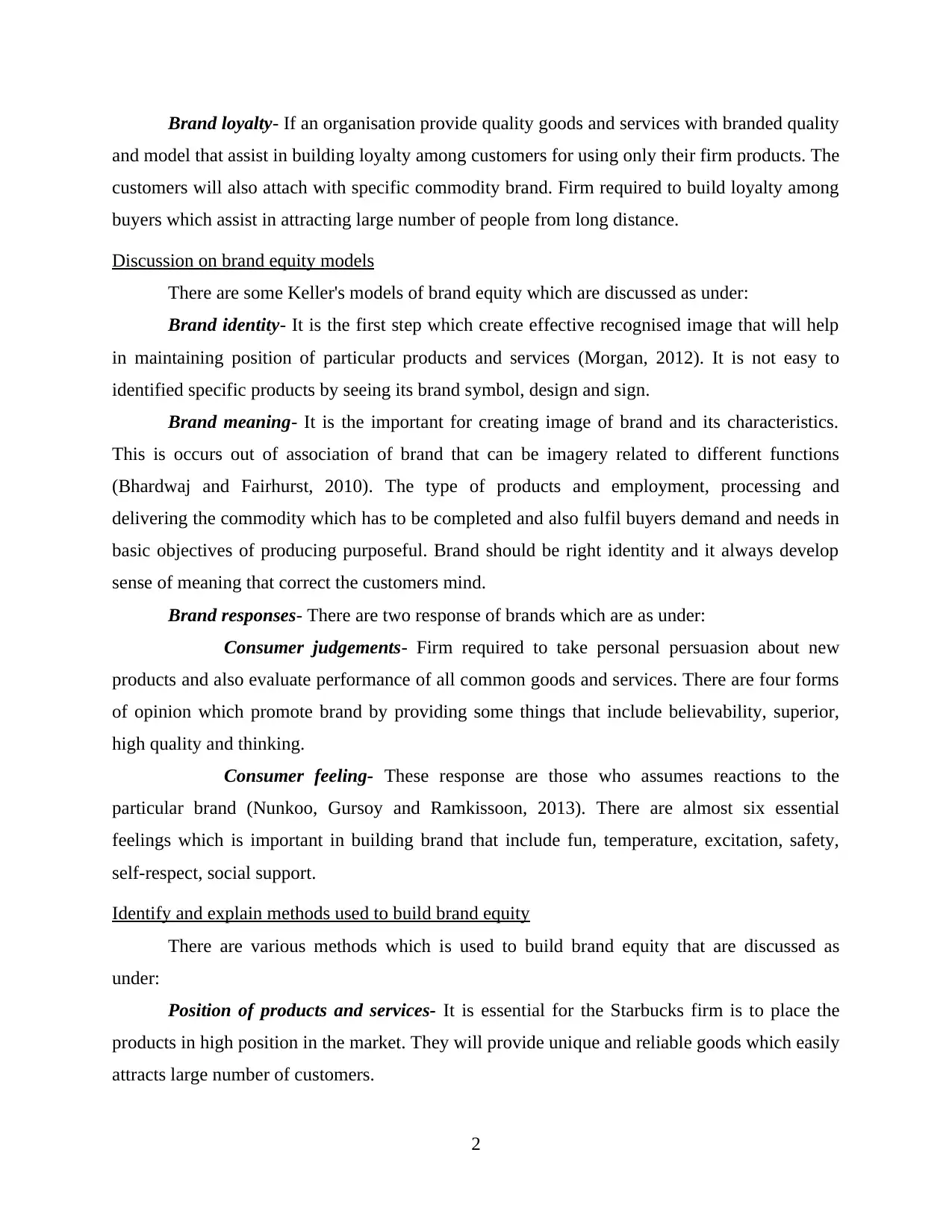
Brand loyalty- If an organisation provide quality goods and services with branded quality
and model that assist in building loyalty among customers for using only their firm products. The
customers will also attach with specific commodity brand. Firm required to build loyalty among
buyers which assist in attracting large number of people from long distance.
Discussion on brand equity models
There are some Keller's models of brand equity which are discussed as under:
Brand identity- It is the first step which create effective recognised image that will help
in maintaining position of particular products and services (Morgan, 2012). It is not easy to
identified specific products by seeing its brand symbol, design and sign.
Brand meaning- It is the important for creating image of brand and its characteristics.
This is occurs out of association of brand that can be imagery related to different functions
(Bhardwaj and Fairhurst, 2010). The type of products and employment, processing and
delivering the commodity which has to be completed and also fulfil buyers demand and needs in
basic objectives of producing purposeful. Brand should be right identity and it always develop
sense of meaning that correct the customers mind.
Brand responses- There are two response of brands which are as under:
Consumer judgements- Firm required to take personal persuasion about new
products and also evaluate performance of all common goods and services. There are four forms
of opinion which promote brand by providing some things that include believability, superior,
high quality and thinking.
Consumer feeling- These response are those who assumes reactions to the
particular brand (Nunkoo, Gursoy and Ramkissoon, 2013). There are almost six essential
feelings which is important in building brand that include fun, temperature, excitation, safety,
self-respect, social support.
Identify and explain methods used to build brand equity
There are various methods which is used to build brand equity that are discussed as
under:
Position of products and services- It is essential for the Starbucks firm is to place the
products in high position in the market. They will provide unique and reliable goods which easily
attracts large number of customers.
2
and model that assist in building loyalty among customers for using only their firm products. The
customers will also attach with specific commodity brand. Firm required to build loyalty among
buyers which assist in attracting large number of people from long distance.
Discussion on brand equity models
There are some Keller's models of brand equity which are discussed as under:
Brand identity- It is the first step which create effective recognised image that will help
in maintaining position of particular products and services (Morgan, 2012). It is not easy to
identified specific products by seeing its brand symbol, design and sign.
Brand meaning- It is the important for creating image of brand and its characteristics.
This is occurs out of association of brand that can be imagery related to different functions
(Bhardwaj and Fairhurst, 2010). The type of products and employment, processing and
delivering the commodity which has to be completed and also fulfil buyers demand and needs in
basic objectives of producing purposeful. Brand should be right identity and it always develop
sense of meaning that correct the customers mind.
Brand responses- There are two response of brands which are as under:
Consumer judgements- Firm required to take personal persuasion about new
products and also evaluate performance of all common goods and services. There are four forms
of opinion which promote brand by providing some things that include believability, superior,
high quality and thinking.
Consumer feeling- These response are those who assumes reactions to the
particular brand (Nunkoo, Gursoy and Ramkissoon, 2013). There are almost six essential
feelings which is important in building brand that include fun, temperature, excitation, safety,
self-respect, social support.
Identify and explain methods used to build brand equity
There are various methods which is used to build brand equity that are discussed as
under:
Position of products and services- It is essential for the Starbucks firm is to place the
products in high position in the market. They will provide unique and reliable goods which easily
attracts large number of customers.
2
Paraphrase This Document
Need a fresh take? Get an instant paraphrase of this document with our AI Paraphraser

Resolve all problems of customers- It is important for the company is to solve all
necessary issues and problems which arises during purchasing of goods and services (Akroush
and Al-Mohammad, 2010). The department of customer services are help in finding solution
which are relates to commodity quality, shape, design and colour by the buyers.
Clear about firms position in marketplace- It is necessary for the firm is to analyse
whole market and also examine position of enterprise in the large marketplace. This will assist in
evaluating exact position of company.
Train the employees for developing innovative brand- The cited organisation will assist
in providing training and development sessions that increasing their skills and knowledge. This
will help in making innovative goods and services and serve in the marketplace.
Describe how organisations measure brand equity
There are various point of view that will used in measuring brand equity. The firm will
required to clarify their brand equity perspective which shows financial position of the company
to the customers. It is that approach which changes and directly effect on new goods and services
on the present brand. Second step is to determine the brand of equity and also analyse whole
market goals and objectives that will help in measuring it. There are two researching functions
such as search mechanics, expand power of brand and path (Freyer, 2011). This will concentrate
on make particular comparison among different competitive products or services. Third is to
evaluate buyers attitudes towards purchasing specific goods and services. They are generally
focus on gaining experience of customers with brands.
Brand reinforcement and brand revitalisation as techniques to manage brand equity
Brand reinforcement refers to maintaining equity of brands. Firm also manage marketing
activities which help in attracting more customers in the marketplace. This will support in
evaluating brand image and meaning which is used in making effective strategies. Reinforcement
strategies reduces by many other reasons such as development of latest technologies, change in
buyers demands and wants and also cage their taste and preferences. There are some things
which includes in brand reinforcement: First, maintaining brand uniformity which increase brand
reputation in positive manner among large number of buyers (Wang and Davidson, 2010). It will
also used in lead consumers to enhance brand and its uniqueness which easily attracts customers
towards them. Starbucks also adopt these techniques which help in increasing brand image
among buyers. Second one is the protect various sources of brand equity that will try to protect
3
necessary issues and problems which arises during purchasing of goods and services (Akroush
and Al-Mohammad, 2010). The department of customer services are help in finding solution
which are relates to commodity quality, shape, design and colour by the buyers.
Clear about firms position in marketplace- It is necessary for the firm is to analyse
whole market and also examine position of enterprise in the large marketplace. This will assist in
evaluating exact position of company.
Train the employees for developing innovative brand- The cited organisation will assist
in providing training and development sessions that increasing their skills and knowledge. This
will help in making innovative goods and services and serve in the marketplace.
Describe how organisations measure brand equity
There are various point of view that will used in measuring brand equity. The firm will
required to clarify their brand equity perspective which shows financial position of the company
to the customers. It is that approach which changes and directly effect on new goods and services
on the present brand. Second step is to determine the brand of equity and also analyse whole
market goals and objectives that will help in measuring it. There are two researching functions
such as search mechanics, expand power of brand and path (Freyer, 2011). This will concentrate
on make particular comparison among different competitive products or services. Third is to
evaluate buyers attitudes towards purchasing specific goods and services. They are generally
focus on gaining experience of customers with brands.
Brand reinforcement and brand revitalisation as techniques to manage brand equity
Brand reinforcement refers to maintaining equity of brands. Firm also manage marketing
activities which help in attracting more customers in the marketplace. This will support in
evaluating brand image and meaning which is used in making effective strategies. Reinforcement
strategies reduces by many other reasons such as development of latest technologies, change in
buyers demands and wants and also cage their taste and preferences. There are some things
which includes in brand reinforcement: First, maintaining brand uniformity which increase brand
reputation in positive manner among large number of buyers (Wang and Davidson, 2010). It will
also used in lead consumers to enhance brand and its uniqueness which easily attracts customers
towards them. Starbucks also adopt these techniques which help in increasing brand image
among buyers. Second one is the protect various sources of brand equity that will try to protect
3

the existing sources which relates to brand equity. They were also focus on internal and external
factors which directly affects in minimising these factors. Third step is investment in which firm
required to invest capital and also develop money for brand. Finally last step is helpful in
marketing programs that will assist in improving products and services and also perform
functions of desired outcomes (Linoff and Berry, 2011). This will create potential results that
will help in making new and innovative strategies in effective manner. It can aid in maintaining
and strength of the organisation that will provide quality of brand equity.
Developing a brand strategy for Starbucks to establish its brand in Sri Lanka
Starbucks is a company which provide coffee to the desired customers in the country.
There are various steps which help in developing brand strategies which are as under:
Analyse overall business strategies- It is most important aspect for analyse whole
business operations and functions. They required to develop suitable strategies for firm.
Recognise target customers- They should also identified target buyers who always
purchase goods and services by the cited organisation (Wei, 2010).
Search target clients- An enterprise also search target and segmented clients who are
willing to buy specific goods.
Develop position of brands- They required to provide top position to the brand that will
used in take place in the marketplace.
Develop effective message strategies- Also they will make messages techniques which
assist in attracting more customers (Branding and brand equity. 2017).
Develop name and logo of brand- It is necessary to create innovative name and logo to
their branded products which easily differentiated by buyers.
CONCLUSION
As per the above mentioned report it can be concluded that Brand equity is the form of
point of view of individual buyer and it is based on attitudes of consumers which are changes
whether it is positive abilities or result to use brand quality. The firm will required to clarify their
brand equity perspective which shows financial position of the company to the customers.
Reinforcement strategies reduces by many other reasons such as development of latest
technologies, change in buyers demands and wants and also cage their taste and preferences of
desired customers. There are various steps which help in developing brand strategies that include
4
factors which directly affects in minimising these factors. Third step is investment in which firm
required to invest capital and also develop money for brand. Finally last step is helpful in
marketing programs that will assist in improving products and services and also perform
functions of desired outcomes (Linoff and Berry, 2011). This will create potential results that
will help in making new and innovative strategies in effective manner. It can aid in maintaining
and strength of the organisation that will provide quality of brand equity.
Developing a brand strategy for Starbucks to establish its brand in Sri Lanka
Starbucks is a company which provide coffee to the desired customers in the country.
There are various steps which help in developing brand strategies which are as under:
Analyse overall business strategies- It is most important aspect for analyse whole
business operations and functions. They required to develop suitable strategies for firm.
Recognise target customers- They should also identified target buyers who always
purchase goods and services by the cited organisation (Wei, 2010).
Search target clients- An enterprise also search target and segmented clients who are
willing to buy specific goods.
Develop position of brands- They required to provide top position to the brand that will
used in take place in the marketplace.
Develop effective message strategies- Also they will make messages techniques which
assist in attracting more customers (Branding and brand equity. 2017).
Develop name and logo of brand- It is necessary to create innovative name and logo to
their branded products which easily differentiated by buyers.
CONCLUSION
As per the above mentioned report it can be concluded that Brand equity is the form of
point of view of individual buyer and it is based on attitudes of consumers which are changes
whether it is positive abilities or result to use brand quality. The firm will required to clarify their
brand equity perspective which shows financial position of the company to the customers.
Reinforcement strategies reduces by many other reasons such as development of latest
technologies, change in buyers demands and wants and also cage their taste and preferences of
desired customers. There are various steps which help in developing brand strategies that include
4
⊘ This is a preview!⊘
Do you want full access?
Subscribe today to unlock all pages.

Trusted by 1+ million students worldwide
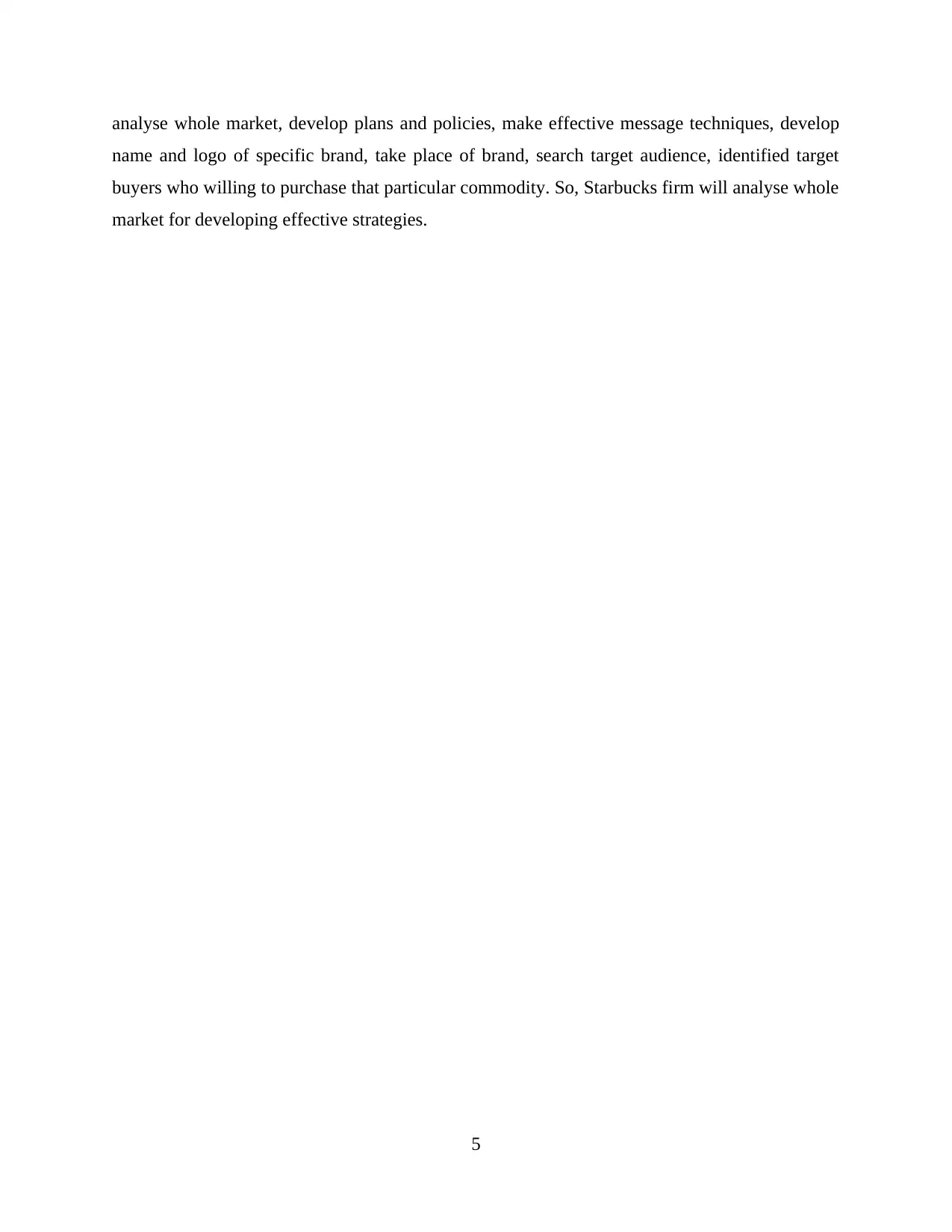
analyse whole market, develop plans and policies, make effective message techniques, develop
name and logo of specific brand, take place of brand, search target audience, identified target
buyers who willing to purchase that particular commodity. So, Starbucks firm will analyse whole
market for developing effective strategies.
5
name and logo of specific brand, take place of brand, search target audience, identified target
buyers who willing to purchase that particular commodity. So, Starbucks firm will analyse whole
market for developing effective strategies.
5
Paraphrase This Document
Need a fresh take? Get an instant paraphrase of this document with our AI Paraphraser
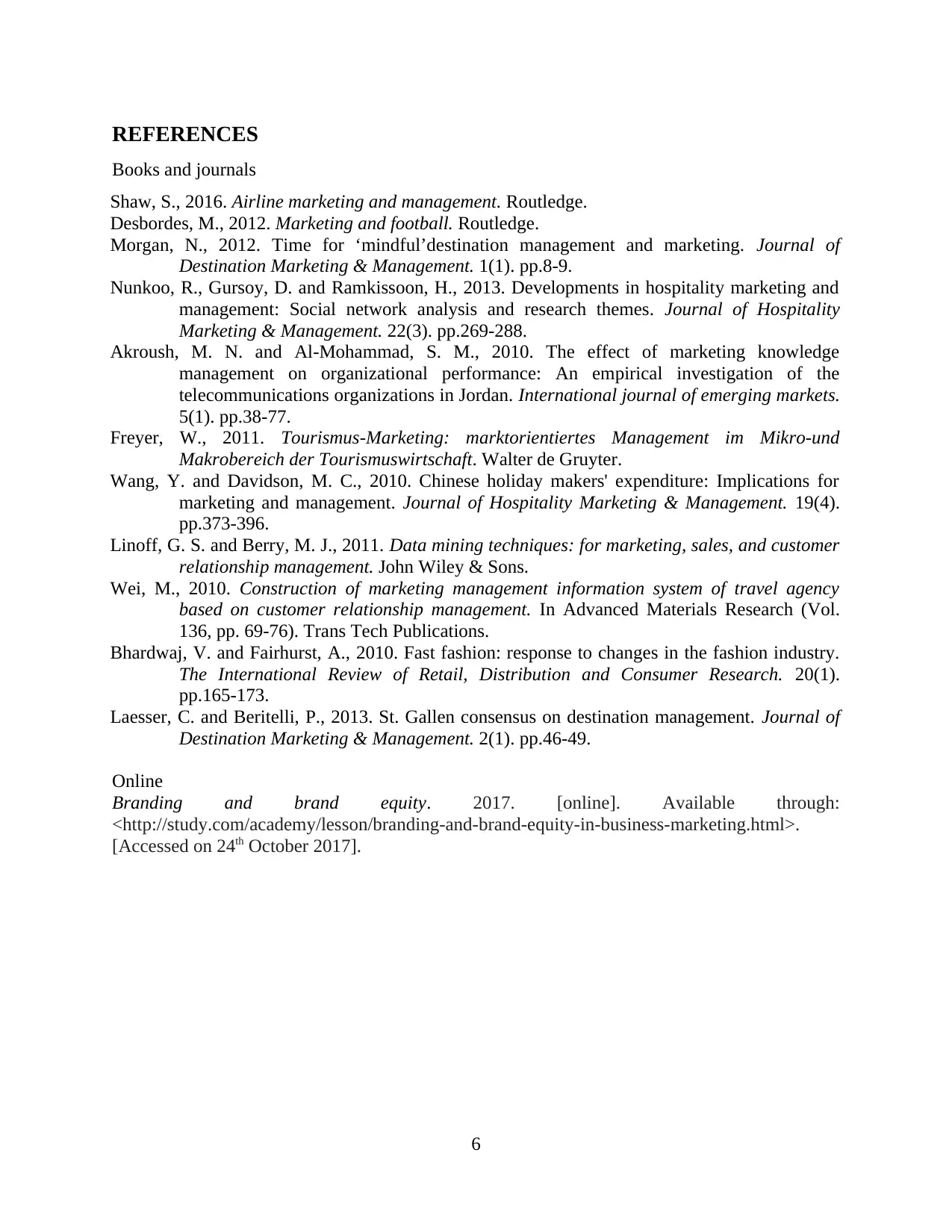
REFERENCES
Books and journals
Shaw, S., 2016. Airline marketing and management. Routledge.
Desbordes, M., 2012. Marketing and football. Routledge.
Morgan, N., 2012. Time for ‘mindful’destination management and marketing. Journal of
Destination Marketing & Management. 1(1). pp.8-9.
Nunkoo, R., Gursoy, D. and Ramkissoon, H., 2013. Developments in hospitality marketing and
management: Social network analysis and research themes. Journal of Hospitality
Marketing & Management. 22(3). pp.269-288.
Akroush, M. N. and Al-Mohammad, S. M., 2010. The effect of marketing knowledge
management on organizational performance: An empirical investigation of the
telecommunications organizations in Jordan. International journal of emerging markets.
5(1). pp.38-77.
Freyer, W., 2011. Tourismus-Marketing: marktorientiertes Management im Mikro-und
Makrobereich der Tourismuswirtschaft. Walter de Gruyter.
Wang, Y. and Davidson, M. C., 2010. Chinese holiday makers' expenditure: Implications for
marketing and management. Journal of Hospitality Marketing & Management. 19(4).
pp.373-396.
Linoff, G. S. and Berry, M. J., 2011. Data mining techniques: for marketing, sales, and customer
relationship management. John Wiley & Sons.
Wei, M., 2010. Construction of marketing management information system of travel agency
based on customer relationship management. In Advanced Materials Research (Vol.
136, pp. 69-76). Trans Tech Publications.
Bhardwaj, V. and Fairhurst, A., 2010. Fast fashion: response to changes in the fashion industry.
The International Review of Retail, Distribution and Consumer Research. 20(1).
pp.165-173.
Laesser, C. and Beritelli, P., 2013. St. Gallen consensus on destination management. Journal of
Destination Marketing & Management. 2(1). pp.46-49.
Online
Branding and brand equity. 2017. [online]. Available through:
<http://study.com/academy/lesson/branding-and-brand-equity-in-business-marketing.html>.
[Accessed on 24th October 2017].
6
Books and journals
Shaw, S., 2016. Airline marketing and management. Routledge.
Desbordes, M., 2012. Marketing and football. Routledge.
Morgan, N., 2012. Time for ‘mindful’destination management and marketing. Journal of
Destination Marketing & Management. 1(1). pp.8-9.
Nunkoo, R., Gursoy, D. and Ramkissoon, H., 2013. Developments in hospitality marketing and
management: Social network analysis and research themes. Journal of Hospitality
Marketing & Management. 22(3). pp.269-288.
Akroush, M. N. and Al-Mohammad, S. M., 2010. The effect of marketing knowledge
management on organizational performance: An empirical investigation of the
telecommunications organizations in Jordan. International journal of emerging markets.
5(1). pp.38-77.
Freyer, W., 2011. Tourismus-Marketing: marktorientiertes Management im Mikro-und
Makrobereich der Tourismuswirtschaft. Walter de Gruyter.
Wang, Y. and Davidson, M. C., 2010. Chinese holiday makers' expenditure: Implications for
marketing and management. Journal of Hospitality Marketing & Management. 19(4).
pp.373-396.
Linoff, G. S. and Berry, M. J., 2011. Data mining techniques: for marketing, sales, and customer
relationship management. John Wiley & Sons.
Wei, M., 2010. Construction of marketing management information system of travel agency
based on customer relationship management. In Advanced Materials Research (Vol.
136, pp. 69-76). Trans Tech Publications.
Bhardwaj, V. and Fairhurst, A., 2010. Fast fashion: response to changes in the fashion industry.
The International Review of Retail, Distribution and Consumer Research. 20(1).
pp.165-173.
Laesser, C. and Beritelli, P., 2013. St. Gallen consensus on destination management. Journal of
Destination Marketing & Management. 2(1). pp.46-49.
Online
Branding and brand equity. 2017. [online]. Available through:
<http://study.com/academy/lesson/branding-and-brand-equity-in-business-marketing.html>.
[Accessed on 24th October 2017].
6

7
⊘ This is a preview!⊘
Do you want full access?
Subscribe today to unlock all pages.

Trusted by 1+ million students worldwide
1 out of 9
Related Documents
Your All-in-One AI-Powered Toolkit for Academic Success.
+13062052269
info@desklib.com
Available 24*7 on WhatsApp / Email
![[object Object]](/_next/static/media/star-bottom.7253800d.svg)
Unlock your academic potential
Copyright © 2020–2025 A2Z Services. All Rights Reserved. Developed and managed by ZUCOL.





